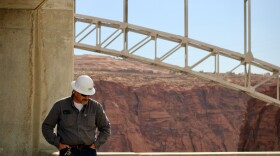Leaders in California, Arizona and Nevada sent a letter to Doug Burgum, the newly-appointed Secretary of the Interior, asking for a fresh review of proposals to manage the shrinking Colorado River.
The seven states that share the river are under pressure to create a new plan for dividing its shrinking supplies before 2026 when the current rules expire. The states that sent the mid-February letter represent the Lower Basin, one of two factions in a tense standoff over new river rules.
“Any actions from decision makers like this, or any communications, have the potential to upend very delicate negotiations that are currently taking place,” said Eric Balken, director of the nonprofit Glen Canyon Institute.
focuses primarily on two things – the previous administration’s process for assessing river management proposals, and the need for infrastructure upgrades at Glen Canyon Dam, which holds back Lake Powell.
The Lower Basin states wrote that the Biden Administration “fail[ed] to consider” their proposal for sharing the river after 2026, despite their “well-documented objections.”
The states also wrote that the Biden Administration issued a report about river management proposals that were out of compliance with The Colorado River Compact, a 1922 legal agreement that has served as a long-standing precedent for sharing water.
“I don't think there was a legal necessity for the letter,” Jim Lochhead, Colorado’s former top water negotiator, told ������Ů. “My own feeling is that the alternatives report appropriately addressed when there might be a potential Compact issue between the states. And I think that's as far as they could go. But, you know, apparently, the Lower Basin’s lawyers feel differently.”
Lochhead said California, Arizona and Nevada are “obviously frustrated.” They appear to suggest that the federal government did not adequately acknowledge their proposal, which suggests larger cutbacks to water use than similar plans put forth by their counterparts in the Upper Basin – Colorado, Utah, Wyoming and New Mexico.

The second issue highlighted in the Lower Basin letter has to do with record low water levels and aging pipes at Glen Canyon Dam. Currently, water passes through hydroelectric generators inside the dam before flowing into the Colorado River. From there the water goes to tens of millions of people and a multibillion agriculture industry in the Lower Basin.
Water experts fear that shrinking supplies and heavy demand will keep straining Lake Powell, bringing the top of the reservoir below the intakes for the generators.
That could leave a set of relatively small, little-used backup pipes as the only means of passing water from Lake Powell to the other side of the dam. The end result would risk the Upper Basin states failing to send a legally required amount of water downstream each year.
In recent years, the federal government has shuffled water from smaller reservoirs into Lake Powell and cut back on water releases to avoid that reality.
The recent letter from the Lower Basin states calls for a more permanent fix.
“The prior administration’s approach to protecting the Lake Powell outlet works by reducing releases from Lake Powell—rather than making infrastructure repairs and improvements—is shortsighted and harms the Lower Basin States,” they wrote. “These profound impacts can be avoided by some combination of straight forward engineering fixes, moving water to Lake Powell from upstream reservoirs when necessary, and temporary reductions in Upper Basin use.”
Balken, whose nonprofit group has been drawing attention to Glen Canyon Dam’s infrastructure issues for years, said the Lower Basin letter addresses something that “environmentalists have been saying for a long time.”
“I think it's just been something that's been put off for a long time,” he said. “But this letter is showing us that we cannot put this off anymore. We have to start talking about modifying Glen Canyon Dam.”
Another Colorado River policy analyst, Mike Cohen of the nonprofit Pacific Institute, said the letter highlights the need for the federal government to give states an ultimatum: If you can’t agree about how to manage the river, we’ll decide for you.
“There needs to be a clear federal voice calling for all seven states to come to a consensus agreement,” he said. “I think the basin states have been successful in the past when they've received that kind of threat. There needs to be this credible threat.”
Cohen said he thinks there is a “pretty good chance” that Burgum is going to make that kind of announcement in the future.
John Entsminger, Nevada’s top water negotiator and a co-author of the recent letter, once described the “federal anvil” hanging over the basin states as an important part of water-sharing talks throughout the past two decades.
Meanwhile, the recent letter seems to argue the opposite.
“The Lower Basin States strongly support a collaborative, consensus-driven approach to developing these guidelines and remain actively engaged in discussions among the seven Colorado River Basin States to reach a unified agreement,” Lower Basin leaders wrote. “An imposed solution or litigation would undermine decades of cooperative progress and jeopardize our ability to continue managing the system effectively.”
In a written statement to ������Ů, an Interior Department spokeswoman said the agency was “actively engaging in dialogue with the Colorado River Basin partners as we work towards long-term operational agreements for the river after 2026.”
This story is part of ongoing coverage of the Colorado River, produced by ������٠in Colorado and supported by the Walton Family Foundation. ������٠is solely responsible for its editorial coverage.







